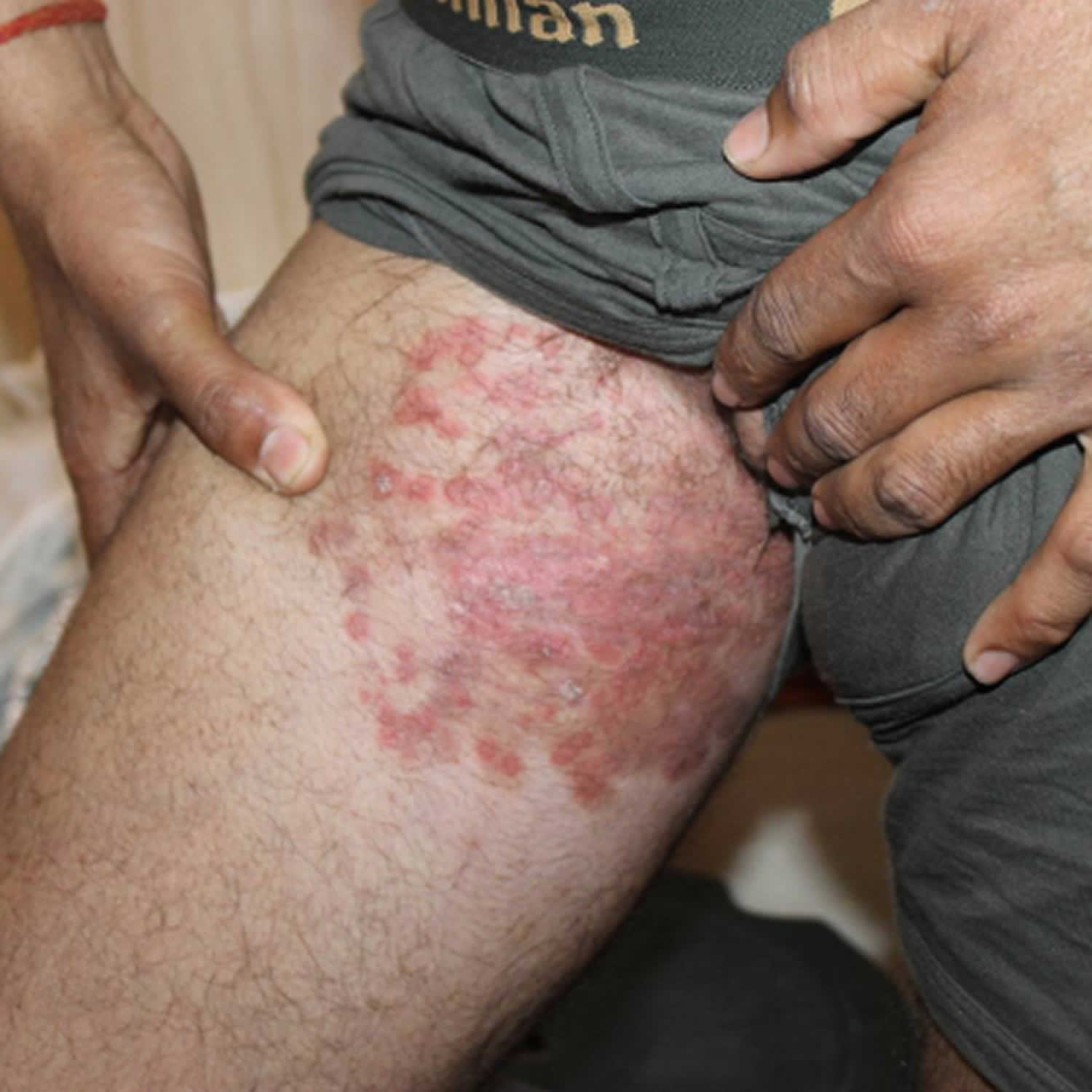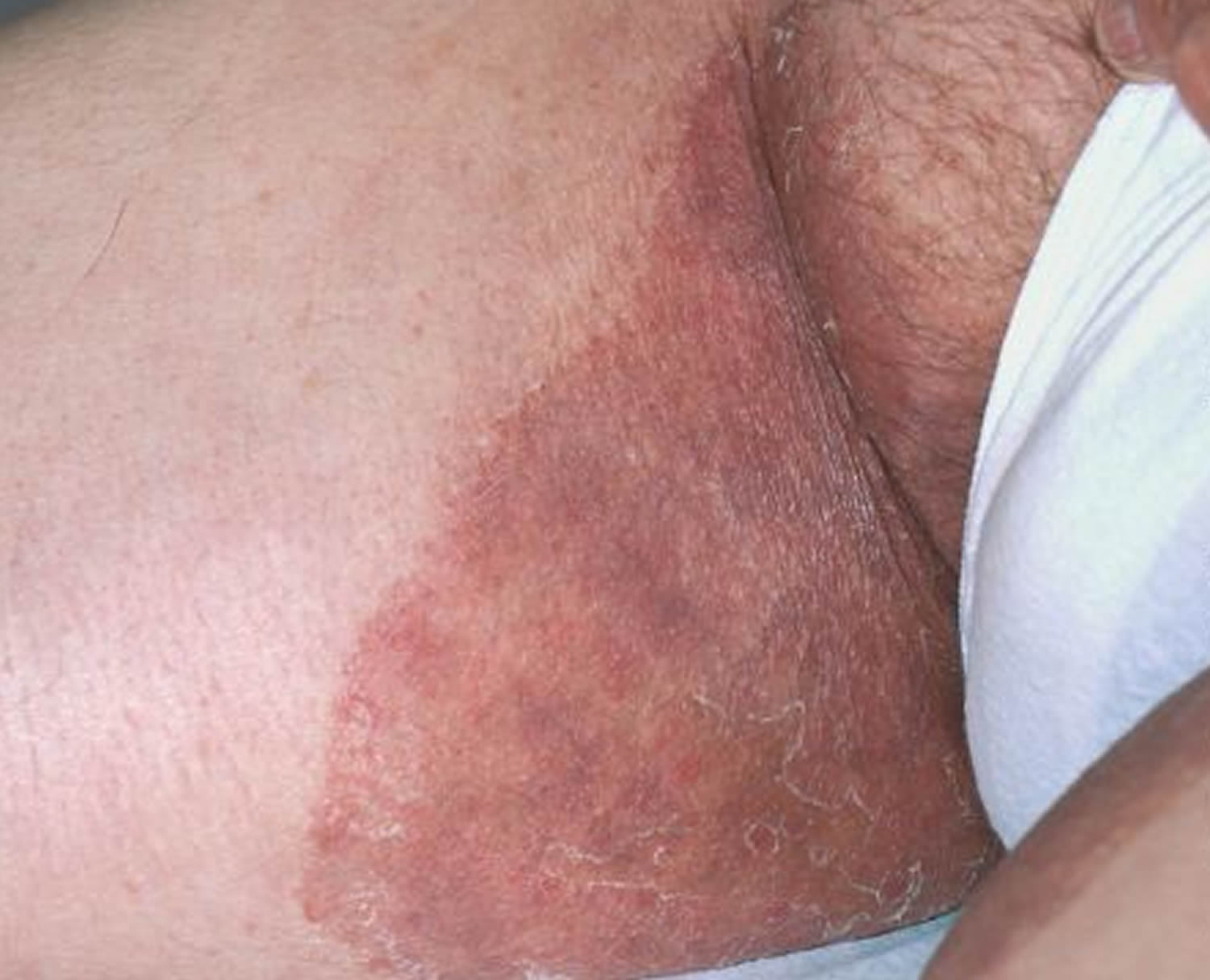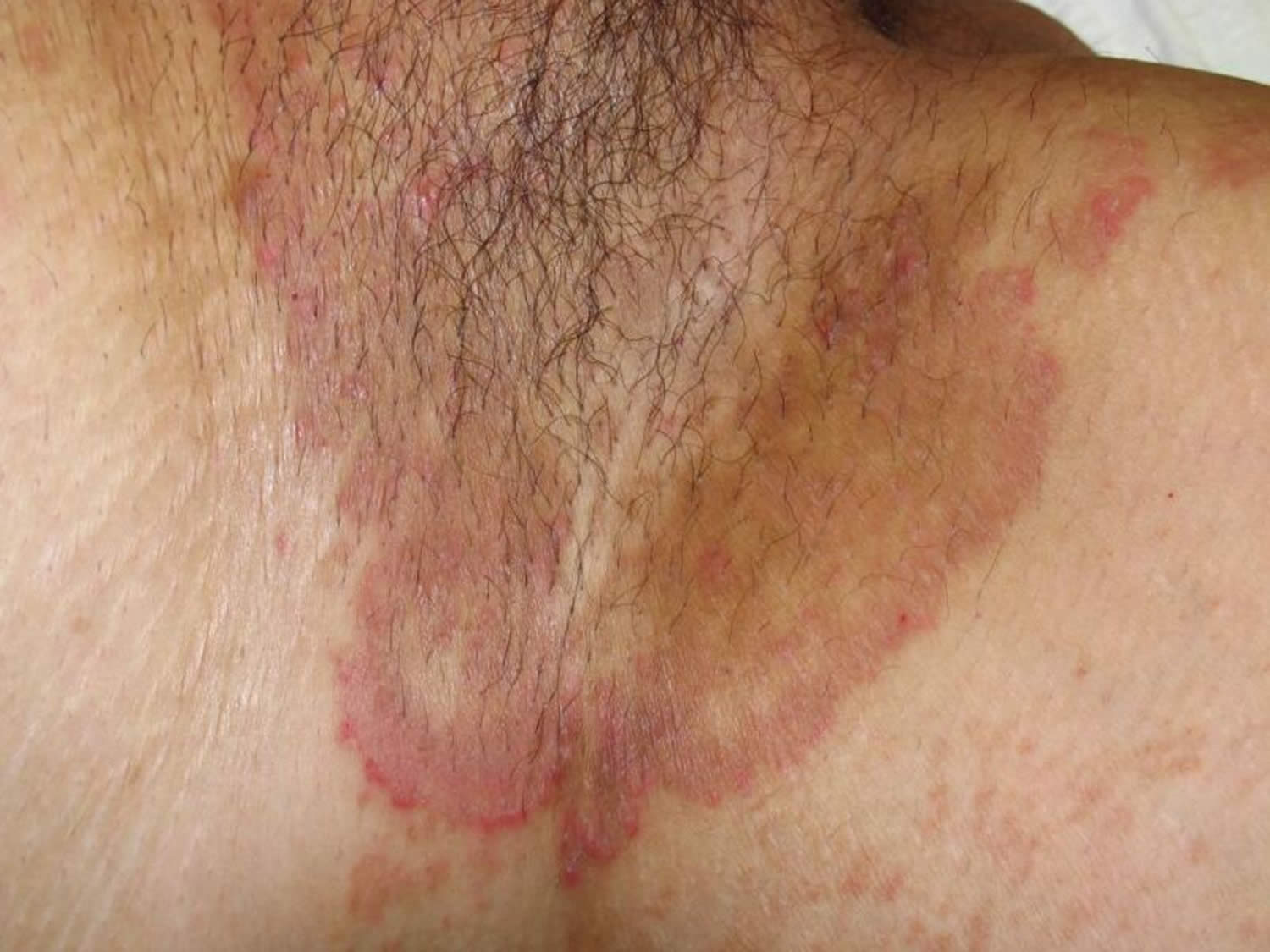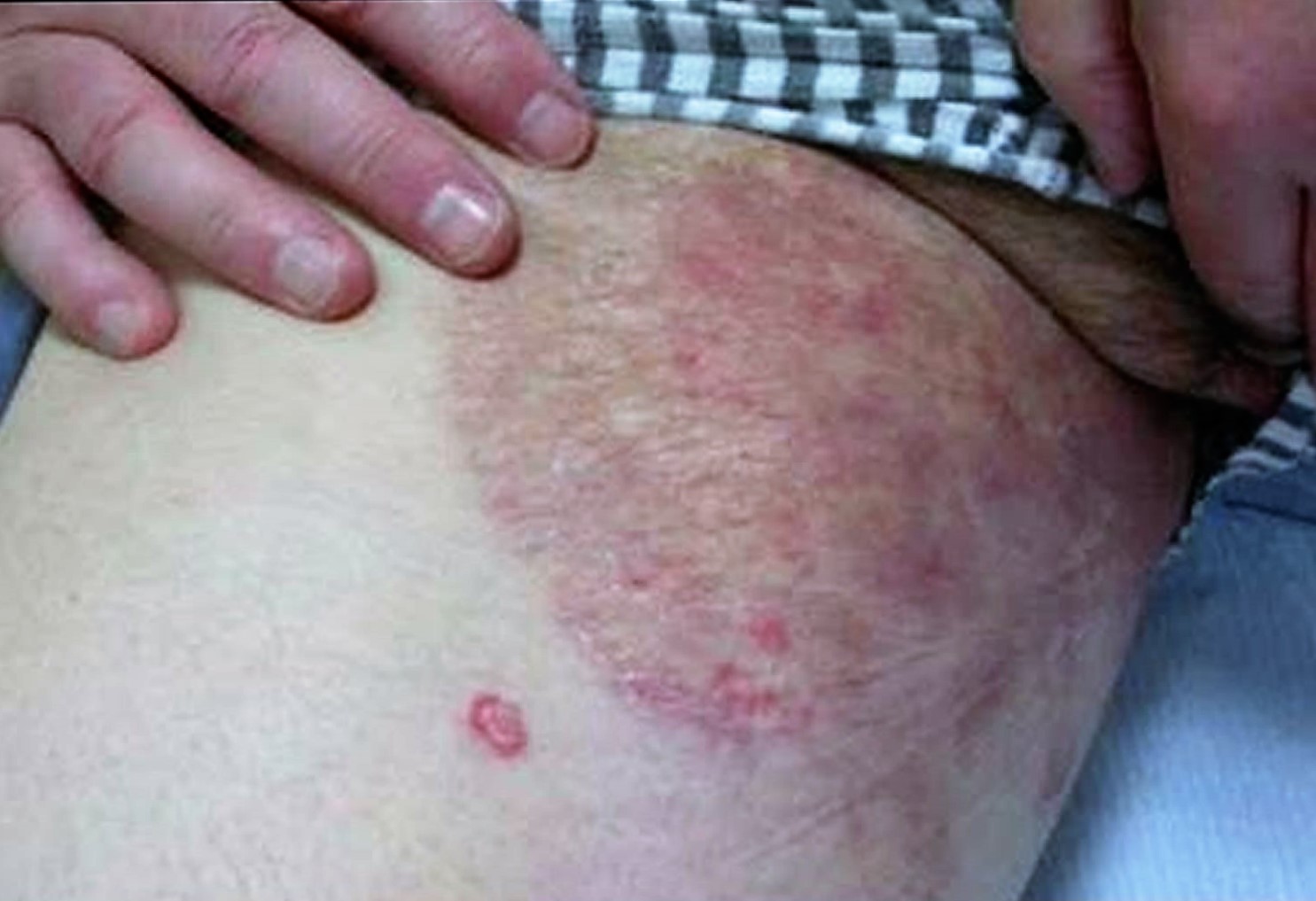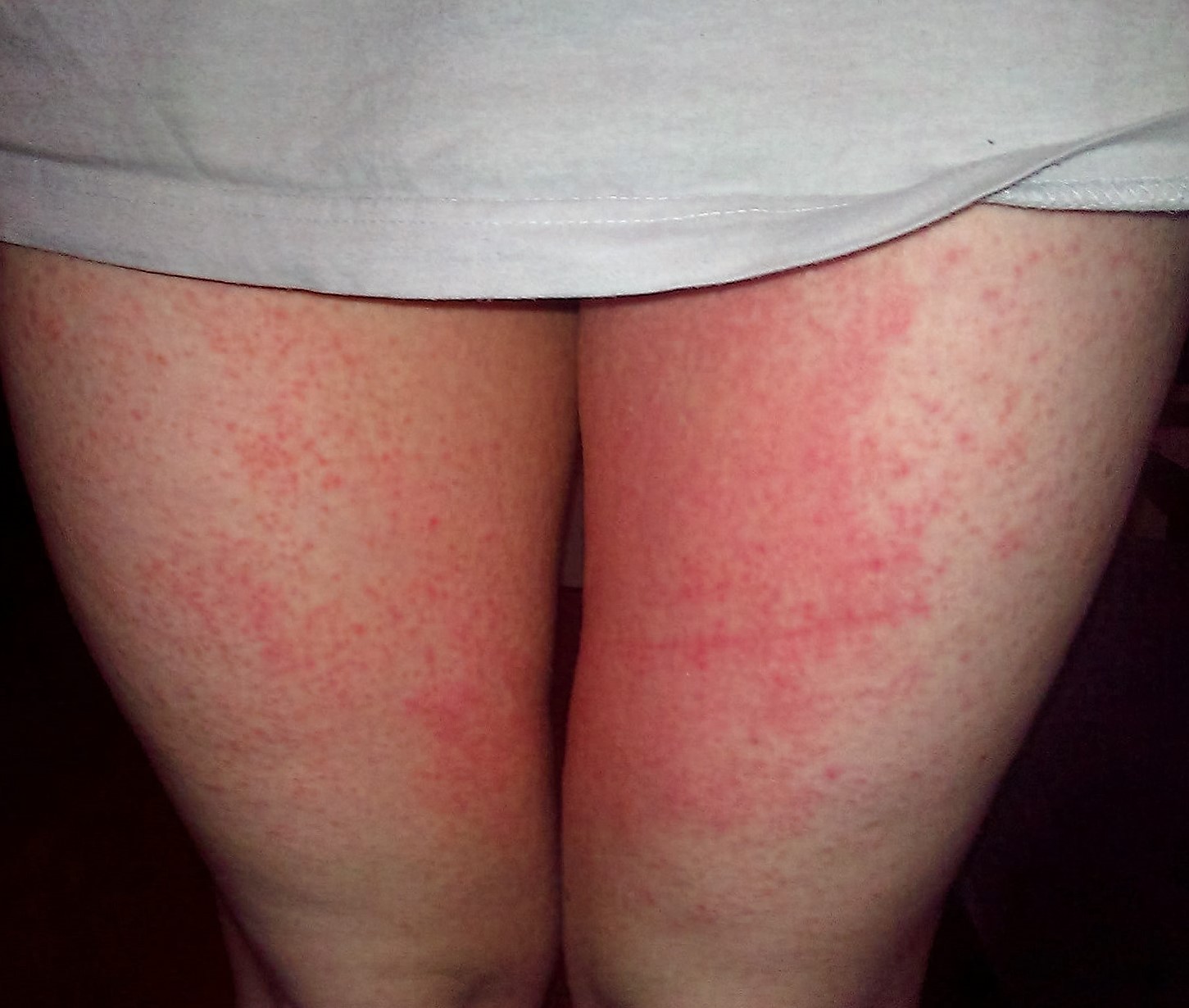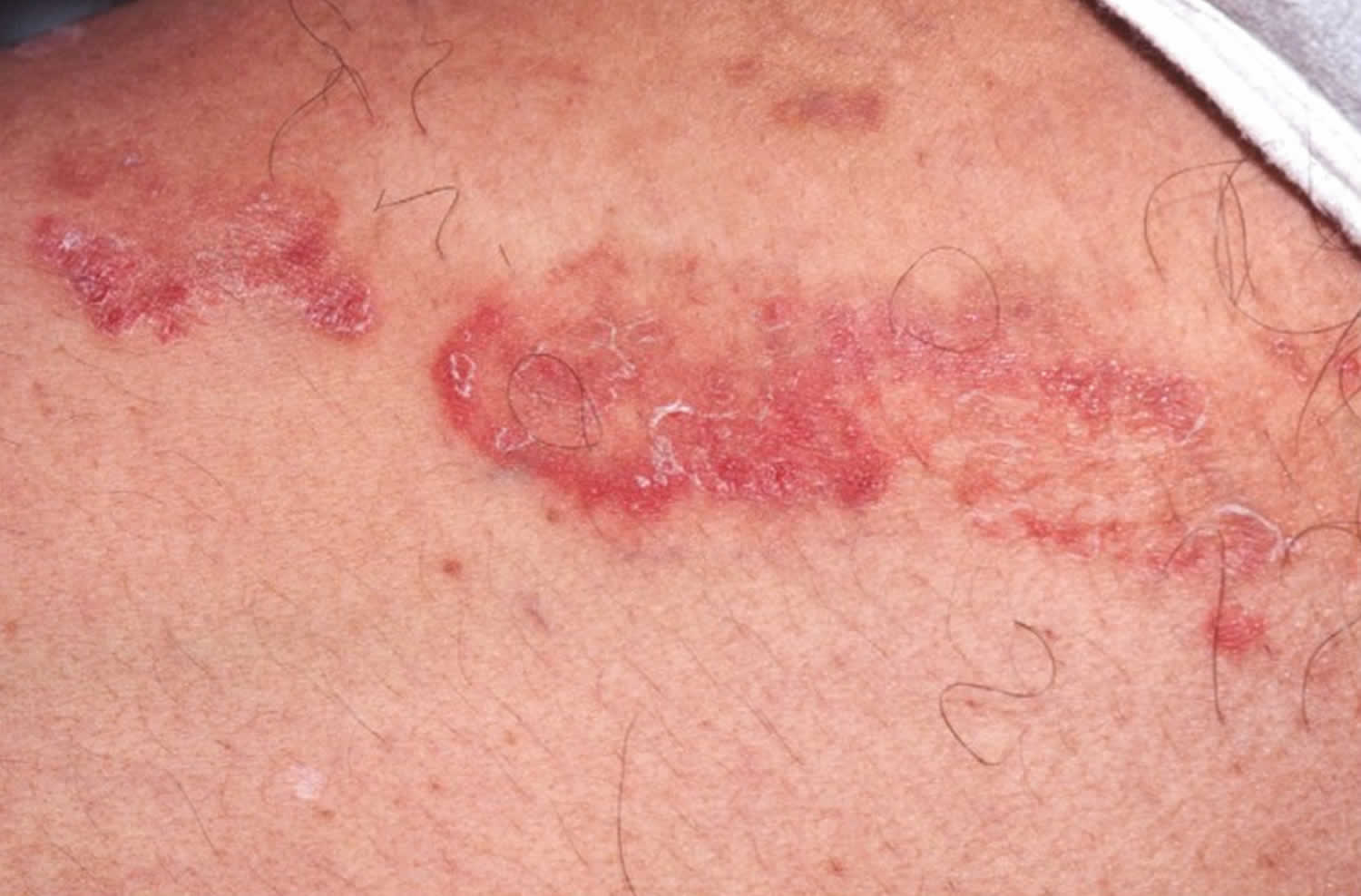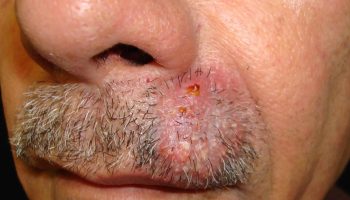Contents
Tinea cruris
Tinea cruris also commonly known as jock itch, is a surface (superficial) fungal or ringworm infection that affects the skin of your genitals, inner thighs and buttocks 1, 2, 3, 4, 5, 6. Tinea cruris is most often seen in adult men. Tinea cruris causes an itchy, red, often ring-shaped rash in these warm, moist areas of your body 7. Tinea cruris gets its name jock itch because it is common in people who sweat a lot, as do athletes. Tinea cruris also is more likely to occur in people who are overweight. Tinea cruris is often spread to the groin from tinea infection on the feet (tinea pedis or athlete’s feet) or nails (tinea unguium) originally, spread by scratching or the use of contaminated towels or bed sheets.
Tinea cruris is very common around the world and is more of a problem in warm, moist regions, as the fungus thrives in these conditions.
Tinea cruris, like other tinea infections, is caused by several types of mold-like fungi called dermatophytes. All of us have microscopic fungi and bacteria living on our bodies, and dermatophytes are among them. Dermatophytes live on the dead tissues of your skin, hair, and nails and thrive in warm, moist areas like the insides of the thighs. So, when the groin area gets sweaty and isn’t dried properly, it provides a perfect environment for the fungi to multiply and thrive.
People who wear tight clothing for extended periods, share clothing, participate in athletics, or are overweight or diabetic are more often affected with tinea cruris.
Although often uncomfortable and bothersome, tinea cruris usually isn’t serious. Keeping your groin area clean and dry and applying topical antifungal creams such as terbinafine (Lamisil) and butenafine (Lotrimin Ultra) usually are sufficient to cure tinea cruris. But oral antifungal agents may be indicated for extensive disease, failed topical treatment, immunocompromised patients 8.
See your doctor if you have a rash on your skin that doesn’t improve within two weeks or if you treat it with over-the-counter antifungal medications and it returns within a few weeks. You may need prescription medication.
Jock itch (tinea cruris) can be confused with other forms of intertrigo such as:
- Candida
- Erythrasma
- Psoriasis
- Seborrheic dermatitis
Jock itch (tinea cruris) quite often recurs after apparently successful treatment. To reduce the chance of reinfection:
- Treat your feet if tinea pedis is present.
- Dry the groin carefully after bathing using a separate towel.
- Do not share towels, sheets or personal clothing.
- Avoid wearing occlusive or synthetic clothing.
- If you are overweight, try to lose weight to reduce chafing and sweating.
When to see a doctor
See your doctor if you have a rash on your skin that doesn’t improve within two weeks or if you treat it with over-the-counter medications and it returns within a few weeks. You may need prescription medication.
Is tinea cruris contagious?
Yes. Tinea infections is a highly contagious fungal skin infection that is spread easily and through close contact with an infected person, animal or object. Don’t share personal items. Don’t let others use your clothing, towels or other personal items. Refrain from borrowing these items from others as well. Tinea cruris (jock itch) is often caused by the same fungus that results in athlete’s foot (tinea pedis). It’s common for the infection to spread from the feet to the groin, as the fungus can travel on your hands or on a towel.
Wear clean clothes. Change your underwear at least once a day or more often if you sweat a lot. Wash workout clothes and athletic supporters after each use or as often as possible.
Tinea cruris treatment over the counter
Check your feet and treat athlete’s foot (tinea pedis) if it is present, as it can often spread from there 9.
Over-the-counter antifungal creams such as miconazole (eg, Monistat®), clotrimazole (Lotrimin®), or tolnaftate (Tinactin®) are very effective. Apply it twice a day until a few days after the rash seems to be gone, which usually takes about 2–3 weeks. You may still see flat, brown areas of discoloration for several weeks, but these do not need to be treated as long as there is no longer itching or bumps and scales in the area.
If you see no improvement after 2 weeks of self-care, see your doctor.
Reinfection can be prevented. Keep the area cool and dry by drying the body thoroughly after bathing and wearing loose cotton clothing. Wash your clothing and linens in hot water. If you think you also have athlete’s foot, use a separate towel for your feet and try to keep your feet dry as well, by avoiding wearing shoes for long periods or wearing loose-fitting shoes. Clean your bath/shower with bleach and floors with an appropriate cleaner to kill any fungal spores. You should also avoid sharing clothing and wear footwear in public bathrooms/showers and gyms. Skin folds can be a continually moist environment that aids growth of this fungus. If this is a recurrent problem for you, it may help to lose weight.
What does tinea cruris look like?
Tinea cruris (jock itch) usually begins with a reddened area of skin in the crease in your groin on one side, which can evolve to become a bilateral but characteristically asymmetrical rash. The rash can extend down the inner aspect of your thigh or to the lower abdomen and pubic area. The rash often spreads to the upper thigh in a half-moon shape. The rash may be ring-shaped and bordered with a line of small blisters. Pustules and vesicles may be present at the (usually raised) active border. Varying amounts of maceration and excoriation may be present in addition to redness and scaling 9. Tinea cruris often occurs with tinea pedis, and the latter may be the source of infection 9.
Tinea cruris (jock itch) may burn or feel itchy, and the skin may be flaky or scaly. Involvement of the buttocks and perineum may be seen but there is typically sparing of the penis, scrotum, and vulva 10.
- Acute tinea cruris may present as a moist and exudative rash.
- Chronic tinea cruris presents as a large well-demarcated scaly plaque with a raised border and central clearing.
- Scale is most prominent at the leading edge of the plaque.
- Dermatophytic folliculitis may present as papules and pustules along the border.
- Tinea cruris is usually itchy.
- Wood lamp examination does not demonstrate fluorescence 11.
- Potassium hydroxide (KOH) preparation microscopy of scrapings from the active border and/or fungal culture may be required for proper diagnosis 9.
Figure 1. Tinea cruris rash
Figure 2. Tinea cruris
Figure 3. Jock itch (tinea cruris)
Figure 4. Tinea cruris female
Figure 5. Tinea cruris (jock itch)
Who gets tinea cruris?
You don’t have to be a jock to get that itch down south. Jock itch is so named because mostly athletes get it. But it can affect anyone who tends to sweat a lot. Jock itch most often affects guys (male 3:1 female), but girls can get it, too. All ages can develop jock itch, adolescents and adults more commonly than children and the elderly. Jock itch can affect all races, being particularly common in hot humid tropical climates.
Some things can make jock itch more likely to develop. These include lots of sweating while playing sports, hot and humid weather, friction from wearing tight clothes for extended periods (like bathing suits), and sharing clothes with others.
People who have certain health conditions such as obesity, diabetes or diseases that cause problems with the immune system are also more likely to develop it.
Predisposing factors for jock itch (tinea cruris) include:
- Longstanding athlete’s foot (tinea pedis)
- Previous episodes of tinea cruris
- Occlusive clothing or tight clothing for extended periods
- Obesity
- Excessive sweating (hyperhidrosis)
- Diabetes mellitus
- Topical steroid use.
Tinea cruris causes
Tinea cruris (jock itch) is caused by a type of dermatophyte fungus belonging to 3 genera, Trichophyton, Epidermophyton, and Microsporum 5. Trichophyton rubrum has been isolated most commonly and remains the most frequent cause of tinea cruris worldwide; however, most studies do recognize the increasing prevalence of Trichophyton mentagrophytes and other organisms such as Epidermophyton floccosum in certain regions 4, 3, 12. Several risk factors have been identified that predispose an individual to jock itch (tinea cruris), including excessive sweating, occlusive clothing, improper hygiene, diabetes mellitus, immunocompromise, and lower socioeconomic status 13, 4, 3.
The dermatophyte fungus can be spread from person to person or from shared use of contaminated towels or clothing. Jock itch is often caused by the same fungus that results in athlete’s foot (tinea pedis) or nails (tinea unguium). It’s common for the infection to spread from the feet or nails to your groin, as the fungus can travel on your hands by scratching or use of contaminated towels or bed sheets.
These dermatophyte fungi affect keratinized structures such as hair and the epidermis’ stratum corneum resulting in a characteristic rash 14. Skin fold areas are hospitable environments for fungus, with sweating, maceration (the softening and breaking down of skin resulting from prolonged exposure to moisture), and alkaline pH being responsible for the groin’s fungal infection 4.
Risk factors for tinea cruris
The organisms that cause tinea cruris thrive in damp, close environments. You’re at greater risk of tinea cruris if you:
- Are a man
- Are a teen or young adult
- Wear tight underwear
- Are overweight or obese
- Sweat heavily (hyperhidrosis)
- Have a weakened immune system
- Have diabetes
Tinea cruris prevention
Reduce your risk of tinea cruris by taking these steps:
- Shower or take a bath daily, and after playing sports.
- Keep the area as dry as possible by always using a clean towel after showering or swimming. Dry your genital area and inner thighs thoroughly with a clean towel after showering or exercising. Use powder around your groin area to prevent excess moisture.
- Wear clean clothes. Change your underwear at least once a day or more often if you sweat a lot. Wash workout clothes after each use.
- Don’t share personal items. Don’t let others use your clothing, towels or other personal items. Refrain from borrowing these items from others as well.
- Wash athletic supporters as often as possible.
- Find the correct fit. Make sure your clothes fit correctly, especially underwear, athletic supporters and sports uniforms. Avoid tight fitting clothes, which can rub and chafe your skin and make you more susceptible to jock itch. Try wearing boxer shorts rather than briefs.
- Treat athlete’s foot. Control any athlete’s foot infection to prevent its spread to the groin. If you spend time in moist public areas, such as a gym shower, wearing sandals will help prevent athlete’s foot.
If you have a fungal infection (ringworm) somewhere else on your body, like athlete’s foot or ringworm, be sure to treat it to help prevent the fungus from spreading to your groin. The best way to prevent the spread is to not touch or scratch your groin area after touching your feet.
Also, use a separate towel on your feet after showering — or if that’s not possible, dry your groin before your feet so the towel doesn’t spread the infection. If you have athlete’s foot, put your socks on before your underwear — this covers your feet so the germs don’t get on your underwear.
Jock itch is pretty common. The good news is it can be avoided through proper care and attention — and it’s easily treated if you do get it.
Tinea cruris symptoms
Tinea cruris usually begins with a reddened area of skin with bumpy, scaling edges that spreads out from the crease in the groin in a half-moon shape onto the upper thigh. The border of the rash may consist of a line of small, raised blisters. The rash often very itchy or burns, and the skin may be flaky or scaly.
Tinea cruris is usually not present on the genitals. Tinea cruris is not often seen on the penis or vulva or around the anus.
Tinea cruris is usually less severe than other tinea infections. If it’s not treated, though, it can last for weeks or months.
Symptoms of tinea cruris include:
- a circular, red, raised rash with elevated edges
- itching, chafing, or burning in the groin, thigh, or anal area
- skin redness in the groin, thigh, or anal area
- flaking, peeling, or cracking skin.
Tinea cruris complications
Failure of therapy and recurrence are the most likely complications of tinea cruris. Failure of therapy and recurrence have been attributed to reinfection from close contacts, autoinfection from separate body locations, infection by uncommon species such as zoonoses, misdiagnosis, drug resistance, and non-adherence to the management plan 3. Topical steroid use may suppress the physical signs of tinea cruris (tinea incognito), making the diagnosis more difficult. Also, chronic topical steroid application can result in skin atrophy and telangiectasias 4. Secondary bacterial infection is another potential complication of tinea cruris 3. Secondary excoriation, lichenification, and pigmentation is another common complication. Majocchi’s granuloma is an uncommon complication of cutaneous fungal infections in which dermatophytes disseminate into the subcutaneous tissue secondary to skin breakdown, immunosuppression, or topical steroid use resulting in a deep, inflammatory disease 15. A dermatophytid reaction may result in an allergic response at a separate location from the original tinea site 16.
Tinea cruris diagnosis
In many cases, your doctor can diagnose tinea cruris simply by looking at the rash. If the diagnosis isn’t clear cut, your doctor may take skin scrapings or samples from the infected area and view them under a microscope or a biopsy if your diagnosis is uncertain. To rule out other conditions, your doctor might send a sample of the rash to a lab. This test is known as a culture.
Tinea cruris can be confused with other forms of intertrigo such as:
- Candida
- Erythrasma
- Psoriasis
- Seborrheic dermatitis
A Wood lamp examination may be helpful to distinguish tinea from erythrasma because the causative organism of erythrasma (Corynebacterium minutissimum) exhibits a coral red fluorescence 11. However, results of the Wood lamp examination can be falsely negative if the patient has bathed recently.
Tinea cruris treatment
For a mild case of tinea cruris, over-the-counter (OTC) antifungal creams, powders, and sprays such as miconazole (eg, Monistat®), clotrimazole (Lotrimin®), or tolnaftate (Tinactin®) will probably clear it up. Terbinafine cream (Lamisil™) is probably the most effective. Apply the antifungal cream twice a day until a few days after the rash seems to be gone, which usually takes about 2–3 weeks. The tinea cruris rash may clear up quickly with these treatments, but continue applying the medication as directed for one to two weeks. Sometimes hydrocortisone is added, for faster relief of itch. Topical steroids should not be used on their own. You may still see flat, brown areas of discoloration for several weeks, but these do not need to be treated as long as there is no longer itching or bumps and scales in the area. Sometimes, though, a person may need to see a doctor for a prescription antifungal cream.
If you also have athlete’s foot, treat it at the same time you are treating your tinea cruris. This will reduce the risk of recurrence. If tinea cruris is severe or doesn’t respond to over-the-counter medicine, you may need prescription-strength creams or ointments — or even antifungal pills.
Resistant culture-confirmed cases will require oral antifungal medicines for one to four weeks, usually terbinafine or itraconazole.
You should hot wash your underwear and towels. And not to share your towels and underwear in order to stop the spread of tinea.
Tinea cruris quite often recurs after apparently successful treatment. To reduce the chance of reinfection:
- Treat your feet if tinea pedis is present.
- Dry the groin carefully after bathing using a separate towel.
- Do not share towels, sheets or personal clothing.
- Avoid wearing occlusive or synthetic clothing.
- If you are overweight, try to lose weight to reduce chafing and sweating.
Reinfection can be prevented. Keep the area cool and dry by drying the body thoroughly after bathing and wearing loose cotton clothing. Wash your clothing and linens in hot water. If you think you also have athlete’s foot, use a separate towel for your feet and try to keep your feet dry as well, by avoiding wearing shoes for long periods or wearing loose-fitting shoes. Clean your bath/shower with bleach and floors with an appropriate cleaner to kill any fungal spores. You should also avoid sharing clothing and wear footwear in public bathrooms/showers and gyms. Skin folds can be a continually moist environment that aids growth of this fungus. If this is a recurrent problem for you, it may help to lose weight.
Tinea corporis (body ringworm), jock itch (tinea cruris), and athlete’s foot (tinea pedis) are generally responsive to topical creams such as terbinafine (Lamisil) and butenafine (Lotrimin Ultra), but oral antifungal agents may be indicated for extensive disease, failed topical treatment, immunocompromised patients, or severe moccasin-type athlete’s foot (tinea pedis) 17.
Patients with chronic or recurrent tinea pedis may benefit from wide shoes, drying between the toes after bathing, and placing lamb’s wool between the toes 18. Patients with tinea gladiatorum, a generalized form of tinea corporis seen in wrestlers, should be treated with topical therapy for 72 hours before return to wrestling 19.
When it comes to healing a fungal infection, it’s essential to keep the affected area clean and dry. Follow these steps when treating jock itch:
- Wash the area, then dry with a clean towel. Use a separate, clean towel on the rest of your body — don’t use the same towel you used on your groin.
- Apply the antifungal cream, powder, or spray as directed on the label. It’s important to continue this treatment for the amount of time recommended in the instructions, even if symptoms disappear sooner, to prevent the infection from coming back.
- Change your clothes, especially your underwear, every day.
- Treat any other fungal infections, such as athlete’s foot. Use antifungal foot powder e.g. ciclopirox (Batrafen®), econazole (Pevaryl®), miconazole (Daktarin®, Fungo®), tolciclate (Tolmicen®), tolnaftate (Tinaderm®), undecylenic acid (Mycota®). Sprinkle it in your shoes.
- In the case of zoophilic fungal infections, infected animals should be identified and treated.
If these steps don’t work, or if symptoms last longer than 2 weeks, see your doctor, who might need to prescribe a stronger antifungal cream, spray, or pill.
Topical antifungal medications
Topical antifungal medications are creams, solutions, lotions, powders, gels, sprays and lacquers applied to the skin surface to treat fungal infections. They can often cure localised infections, although recurrence is common. Many suitable creams can be obtained over the counter without a doctor’s prescription.
Many antifungal medications are suitable for both dermatophyte and yeast infections. Others are more specific to one or the other type of fungus. The medications are listed below, with their trade names in parentheses.
Those unsuitable for dermatophyte fungal infections are marked with an asterix (*).
Preparations for general fungal skin infections
Topical antifungal creams can be used to treat:
- Dermatophyte infections such as tinea corporis, tinea cruris, tinea faciei, tinea manuum, tinea pedis.
- As an adjunct to oral therapy for tinea capitis and tinea barbae.
- Yeast infections such as candida intertrigo, pityriasis versicolor.
- Mould skin infections such as tinea nigra and nail plate infections.
The creams are applied to the affected area twice daily for two to four weeks, including a margin of several centimetres of normal skin. Continue for one or two weeks after the last visible rash has cleared. Repeated treatment is often necessary.
- Whitfield’s ointment (benzoic acid)
- Undecylenic alkanolamide
- Ciclopirox olamine (Batrafen® cream, powder, solution)
- Polyenes * – Nystatin (Nilstat® cream, ointment; Mycostatin® cream, ointment, paste)
- Imidazoles
- Bifonazole (Canesten® Once Daily Bifonazole Cream)
- Clotrimazole (Canesten® cream, solution; Clocreme® cream; Clomazol®, Fungizid® spray)
- Econazole (Ecreme® cream; Pevaryl® cream, powder, foaming solution)
- Ketoconazole (Nizoral® cream, Daktagold® cream)
- Miconazole (Daktarin® cream, lotion, dusting powder, spray powder; Micreme® cream, Resolve® solution, tinea cream, jock itch cream, thrush cream, powder; Tinasolve® Alpha cream)
- Tioconazole
- Allylamine (higher cure rates and more rapid responses than older topical antifungals for dermatophyte infections)
- Terbinafine (Lamisil® cream, gel, spray)
- Thiocarbamates
- Tolciclate
- Tolnaftate
In other countries, additional antifungal agents include the azoles, bifonazole, tioconzaole, sulconazole, efinaconazole and luliconazole; naftifine; and a benzoxaborole, tavaborole.
A meta-analysis by Rotta et al. 20 evaluated the efficacy of antifungal treatment involving 14 different topical antifungals and included 65 randomized controlled trials, comparing topical antifungal with one another or with placebo. Efficacy was evaluated in the form of mycological cure at the end of treatment and sustained cure. They found no statistically significant differences among the antifungals concerning the outcome of mycologic cure at the end of treatment. For sustained cure, butenafine and terbinafine each was found to be superior to clotrimazole 20. Pairwise comparison of topical antifungals for the outcome of fungal cure showed butenafine and terbinafine each to be superior to clotrimazole, oxiconazole, and sertaconazole; terbinafine to be superior to ciclopirox, and naftifine to be superior to oxiconazole 20.
Similarly, Cochrane review on the topical antifungal treatments for jock itch (tinea cruris) and body ringworm infection (tinea corporis) suggests that the individual treatments with terbinafine and naftifine are effective with few side effects 21. Other topical antifungals like azoles treatments are also effective in terms of clinical and mycological cure rates 21.
Combination products
Topical antifungals may be sold with an oral antifungal, e.g. Canesten® combination pack (fluconazole capsule and clotrimazole cream duo).
Antifungal creams are sometimes combined with:
- Hydrocortisone or other topical steroid (e.g. Resolve® Plus cream)
- Antibacterial agents
- Both topical steroid and antibacterial agent
Oral antifungal medications may be required for a fungal infection if:
- It is extensive or severe.
- It resists topical antifungal therapy.
- It affects hair-bearing areas (tinea capitis and tinea barbae).
Oral antifungal medications
Oral antifungal medications may be required for a fungal infection if:
- It is extensive or severe.
- It resists topical antifungal therapy.
- It affects hair-bearing areas (tinea capitis and tinea barbae).
The choice of oral antifungal medication, its dose and the duration of treatment depends on:
- The type of fungus i.e. candida, dermatophyte (tinea), malassezia, or mould.
- The site affected i.e. skin, mucosa, nails.
- Other co-existing diseases.
- Interactions with other medications.
Medications for both candida and dermatophyte infections (azoles)
The trade names of the medications are given in parentheses.
- Itraconazole (Sporanox® capsules).
- Ketoconazole (Nizoral® tablets).
- Fluconazole (Diflucan® capsules).
Voriconazole (Vfend® tablets) and posaconazole are reserved for serious invasive Candida and mould infections.
Some species of candida are resistant to azoles, and azole resistance is increasing especially in immunosuppressed patients who are prescribed long courses.
Medications only suitable for dermatophyte infections
- Griseofulvin, derived from Penicillium
- Terbinafine (Lamisil®, Terbafin® tablets), an allylamine.
Oral systemic antifungals are indicated in case of extensive involvement and patients who fail topical therapy 22. Out of the various systemic antifungals, terbinafine, and itraconazole are commonly prescribed. Griseofulvin and fluconazole are also effective but require long-term treatment. Randomized controlled trials support the efficacy of systemic antifungals 23, 24, 25, 26. Comparative trial between itraconazole 100 mg/day with ultramicronized griseofulvin 500 mg/day for tinea corporis or tinea cruris showed significantly better clinical and mycological outcome in favor of itraconazole after 2 weeks of therapy 24. Similar study comparing terbinafine with griseofulvin (both 500 mg daily for 6 weeks) for tinea corporis found mycological cure rate of about 87% in former group compared to 73% in latter 23. A double-blinded study between itraconazole (100 mg/day) and griseofulvin (500 mg/day) found itraconazole to be superior in providing mycological cure 25.
What is the outcome for tinea cruris?
Tinea cruris clears with appropriate treatment in 80–90% of cases 27. However, tinea cruris recurrence is common, especially if predisposing factors are not addressed or antifungal treatment is stopped before mycological cure. Residual hyperpigmentation may persist in skin of color.
- Gupta AK, Chaudhry M, Elewski B. Tinea corporis, tinea cruris, tinea nigra, and piedra. Dermatol Clin. 2003 Jul;21(3):395-400, v. doi: 10.1016/s0733-8635(03)00031-7[↩]
- Ely JW, Rosenfeld S, Seabury Stone M. Diagnosis and management of tinea infections. Am Fam Physician. 2014 Nov 15;90(10):702-10. https://www.aafp.org/pubs/afp/issues/2014/1115/p702.html[↩]
- Sahoo AK, Mahajan R. Management of tinea corporis, tinea cruris, and tinea pedis: A comprehensive review. Indian Dermatol Online J. 2016 Mar-Apr;7(2):77-86. doi: 10.4103/2229-5178.178099[↩][↩][↩][↩][↩]
- Khurana A, Sardana K, Chowdhary A. Antifungal resistance in dermatophytes: Recent trends and therapeutic implications. Fungal Genet Biol. 2019 Nov;132:103255. doi: 10.1016/j.fgb.2019.103255[↩][↩][↩][↩][↩]
- Sardana K, Kaur R, Arora P, Goyal R, Ghunawat S. Is Antifungal Resistance a Cause for Treatment Failure in Dermatophytosis: A Study Focused on Tinea Corporis and Cruris from a Tertiary Centre? Indian Dermatol Online J. 2018 Mar-Apr;9(2):90-95. doi: 10.4103/idoj.IDOJ_137_17[↩][↩]
- Jock Itch. https://kidshealth.org/en/teens/jock-itch.html[↩]
- Jock itch. Mayo Clinic. https://www.mayoclinic.org/diseases-conditions/jock-itch/symptoms-causes/syc-20353807[↩]
- Diagnosis and Management of Tinea Infections. Am Fam Physician. 2014;90(10):702-711. https://www.aafp.org/pubs/afp/issues/2014/1115/p702.html[↩]
- Hainer BL. Dermatophyte infections. Am Fam Physician. 2003 Jan 1;67(1):101-8. https://www.aafp.org/pubs/afp/issues/2003/0101/p101.html[↩][↩][↩][↩]
- Reiss E, Shadomy HJ, Lyon GM., III . Fundamental Medical Mycology. Hoboken, NJ: Wiley-Blackwell; 2012. Dermatophytosis; pp. 527–66.[↩]
- Gupta AK, Chaudhry M, Elewski B. Tinea corporis, tinea cruris, tinea nigra, and piedra. Dermatol Clin. 2003;21:395–400. doi: 10.1016/S0733-8635(03)00031-7[↩][↩]
- Richardson MD, Moore CB, Summerbell RC, Gupta AK. Superficial and subcutaneous fungal pathogens. In: Cohen J, Powderly WG, Opal SM, editors. Infectious Diseases. 3rd Edition. Maryland Heights, MO: Mosby Elsevier; 2010. pp. 1853–67.[↩]
- Gupta AK, Foley KA, Versteeg SG. New Antifungal Agents and New Formulations Against Dermatophytes. Mycopathologia. 2017 Feb;182(1-2):127-141. doi: 10.1007/s11046-016-0045-0[↩]
- Pippin MM, Madden ML, Das M. Tinea Cruris. [Updated 2022 Jun 5]. In: StatPearls [Internet]. Treasure Island (FL): StatPearls Publishing; 2022 Jan-. Available from: https://www.ncbi.nlm.nih.gov/books/NBK554602[↩]
- Trocoli Drakensjö I, Vassilaki I, Bradley M. Majocchis Granuloma Caused by Trichophyton mentagrophytes in 2 Immunocompetent Patients. Actas Dermosifiliogr. 2017 Jan-Feb;108(1):e6-e8. English, Spanish. doi: 10.1016/j.ad.2015.05.020[↩]
- Mayser P. Dermatophytid : Aktuelle Bestandsaufnahme [Dermatophyte : Current situation]. Hautarzt. 2017 Apr;68(4):316-323. German. doi: 10.1007/s00105-017-3933-4[↩]
- Diagnosis and Management of Tinea Infections. Am Fam Physician. 2014 Nov 15;90(10):702-711. http://www.aafp.org/afp/2014/1115/p702.html[↩]
- Athlete’s foot, ringworm of the feet. In: Pickering LK, Baker CJ, Kimberlin DW, et al. Red Book: 2012 Report of the Committee on Infectious Diseases. Elk Grove Village, Ill.: American Academy of Pediatrics.[↩]
- Tinea corporis, ringworm of the body. In: Pickering LK, Baker CJ, Kimberlin DW, et al. Red Book: 2012 Report of the Committee on Infectious Diseases. Elk Grove Village, Ill.: American Academy of Pediatrics.[↩]
- Rotta I, Ziegelmann PK, Otuki MF, Riveros BS, Bernardo NL, Correr CJ. Efficacy of topical antifungals in the treatment of dermatophytosis: a mixed-treatment comparison meta-analysis involving 14 treatments. JAMA Dermatol. 2013 Mar;149(3):341-9. doi: 10.1001/jamadermatol.2013.1721[↩][↩][↩]
- El-Gohary M, van Zuuren EJ, Fedorowicz Z, Burgess H, Doney L, Stuart B, Moore M, Little P. Topical antifungal treatments for tinea cruris and tinea corporis. Cochrane Database Syst Rev. 2014 Aug 4;(8):CD009992. doi: 10.1002/14651858.CD009992.pub2[↩][↩]
- Lesher JL Jr. Oral therapy of common superficial fungal infections of the skin. J Am Acad Dermatol. 1999 Jun;40(6 Pt 2):S31-4. doi: 10.1016/s0190-9622(99)70395-6[↩]
- Cole GW, Stricklin G. A Comparison of a New Oral Antifungal, Terbinafine, With Griseofulvin as Therapy for Tinea Corporis. Arch Dermatol. 1989;125(11):1537–1539. doi:10.1001/archderm.1989.01670230079013[↩][↩]
- Bourlond, A., Lachapelle, J.M., Aussems, J., Boyden, B., Campaert, H., Conincx, S., Decroix, J., Geeraerts, C., Ghekiere, L., Porters, J., Speelman, G., Tennstedt, D., Kint, T., Vandaele, R., Van Den Haute, V., Van Lint, L. and Willocx, D. (1989), Double-Blind Comparison of Itraconazole with Griseofulvin in the Treatment of Tinea Corporis and Tinea Cruris. International Journal of Dermatology, 28: 410-412. https://doi.org/10.1111/j.1365-4362.1989.tb02491.x[↩][↩]
- Panagiotidou D, Kousidou T, Chaidemenos G, Karakatsanis G, Kalogeropoulou A, Teknetzis A, Chatzopoulou E, Michailidis D. A comparison of itraconazole and griseofulvin in the treatment of tinea corporis and tinea cruris: a double-blind study. J Int Med Res. 1992 Sep;20(5):392-400. doi: 10.1177/030006059202000504[↩][↩]
- Faergemann J, Mörk NJ, Haglund A, Odegård T. A multicentre (double-blind) comparative study to assess the safety and efficacy of fluconazole and griseofulvin in the treatment of tinea corporis and tinea cruris. Br J Dermatol. 1997 Apr;136(4):575-7.[↩]
- Hay R. Therapy of Skin, Hair and Nail Fungal Infections. J Fungi (Basel). 2018 Aug 20;4(3):99. doi: 10.3390/jof4030099[↩]
